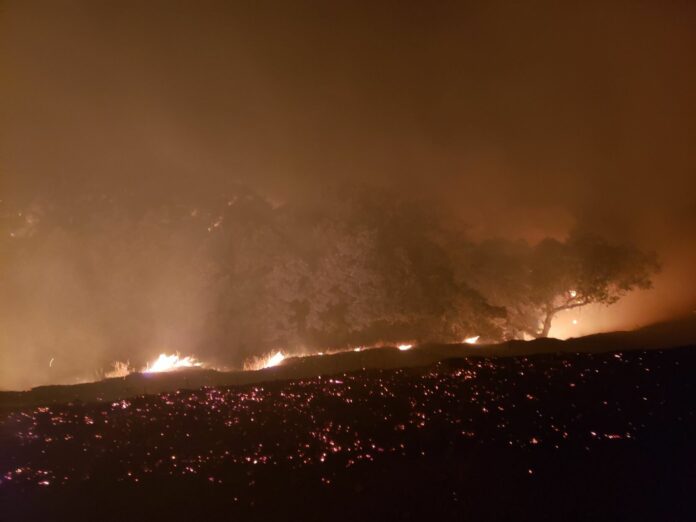Erosion, sediment, ash movement into lake a concern
Sonoma Water, in partnership with the U.S. Army Corps of Engineers, made a request this week through the Sonoma County Office of Emergency Management and CalFire for the mobilization of a Watershed Emergency Response Team (WERT), a state team than can assess the damage and propose mitigation plans for a five-mile stretch of the Lake Sonoma area that burned in the Walbridge Fire.
Sonoma Water General Manager Grant Davis, the U.S. Army Corps of Engineers (the entity that owns and maintains Lake Sonoma) and Sonoma County Supervisors James Gore and David Rabbitt, toured the lake yesterday afternoon, Aug. 25, to assess the damage from the fire and to determine what type of response they’ll require for restoration efforts.
Davis said the narrow band of the Warm Springs arm of the lake near the Quicksilver campground and up to Buck Pasture saw fire activity that came all the way down to the lake.
“It’s upwards of five miles of lake area that we are having to assess right now, and I’d say that it is a good quarter of the lake,” Davis said. “And the concern is that there are some very steep ravines and a very large section of the lake that provides the lion’s share of the drinking water for 600,000 people in Sonoma and Marin County, and what we are most worried about now is all of the ash and the carbon, the materials that have been set and now burned into that area and we need to find a way to protect the water supply from those sediments.”
In a video with District 4 Supervisor James Gore, Cloverdale Fire Chief Jason Jenkins described how the tendrils of the Walbridge Fire made its way down the lake. He called the burn an understory burn, meaning most of the fire in the area was focused in the undergrowth of the trees rather in the crown, or canopy, of the trees.
“What I see when I look at this is an understory burn. The fire on this slope was predominantly a backing fire, it backed down and crept its way back down to the lake’s edge. For the most part it’s pretty healthy. There will be some issues with erosion that could put the lake and water quality at risk, but for a fire, it cleaned a lot of the understory and underbrush out and it didn’t burn with the greatest intensity where it torched out,” Jenkins explained.
Davis said the water they supply to communities from the Russian River is safe to drink and has not been directly affected by the fire.
However, as the rainy season approaches, erosion in the burn areas does pose a risk in terms of getting sediment, ash and materials from retardant down into the lake.
“The other part of it (the water concerns) is the water quality with the chemicals that get released from the ash and from the burnt soil. They can be released into the water in the reservoir but also into the streams,” Sonoma Water Chief Engineer Jay Jaspers said in the same video with Jenkins.
This is why creating a watershed restoration plan with a WERT will be a vital step to recovery, and Davis said it will be a race against time to get the work done before winter sets in.
“It is a state form of assistance that would allow us to bring in the technical experts to assess where the highest priority problems are, where the ravines are and where the interface with the lake is likely to occur and what type of restoration work we can prepare for between now and the winter/fall rains,” Davis said. “It’s really kind of a race against time at this point.”
Davis said following the 2017 Sonoma Complex Fires and the 2019 Kincade Fire, Sonoma Water also had WERTs respond to measure water quality and create mitigation measures. He said they need these evaluations completed to help determine where the biggest threats to the watershed are and how to mitigate them.
“Here we are in 2020 and it’s a repeat performance,” he said.
In the past, mitigation measures have consisted of installing a series of straw wattles, erosion control devices made of straw and rice that are laid down in areas where erosion is likely to occur after a wildfire.
“It’s basically building a series of hurdles for erosion and sediment to get over to try and keep it out of the waterway,” Davis said. “That is primarily one of the largest forms in which you put these abutments together and it’s pretty labor intensive. When I’m looking at five miles of lakefront, that’s going to be quite a challenge.”
Lower Russian River watershed
One of the biggest concerns for Sonoma Water was the Wohler and Mirabel water diversion stations, which were both threatened by the fire on the southern flank.
“When it comes to our facilities at the Wohler and Mirabel diversion we have six large groundwater wells there. That area is still under an evacuation zone and since the fires began we’ve been very worried and had to watch those facilities to make sure that the fire did not get there, that would really be a problem,” Davis said.
The deep groundwater wells there act as a sort of natural filtration system. As the water comes through and is drawn out of the ground the natural gravel acts as a filtration system and gets clean water to some 600,000 residents.
“The aquifer provides the natural treatment and you pull the water up 150 feet up to our ponds and then that is what we ship out to the customers, Windsor, Santa Rosa and south of Healdsburg,” Davis said.
Sonoma County Emergency Operations Center Director, Chris Godley, called these facilities, “irreplaceable infrastructure,” and had said that fire engine strike teams were going to keep an eye on those stations.
Davis commended the firefighters and the crews that have been out there for a better part of the week trying to maintain the breaks and keep the fire at bay.
“I am so grateful to CalFire and our local firefighters. They did make it a priority and they knew that that was irreplaceable assets,” Davis said. “We’ve really had a very challenging time of it where this fire is moving and how it has evolved.”
Davis reiterated that water supplied to homes from the Russian River is still safe to use and drink.
“Water supplied for communities that get water from us out of the Russian River is quite safe to do so (to use and drink). The water supply is safe. The 150 feet of gravel that I described is incredibly unique and an important part of the water quality component of our system,” he said.
The request for the WERT has gone on to CalFire and the hope would be that the state would authorize a team to be developed to work with Sonoma Water and local watershed task force teams to start planning a strategy for priority areas of restoration.
“I envision us putting together a team that will focus on Lake Sonoma, on Dry Creek, the tributaries and the tributaries above Dry Creek,” Davis said.









